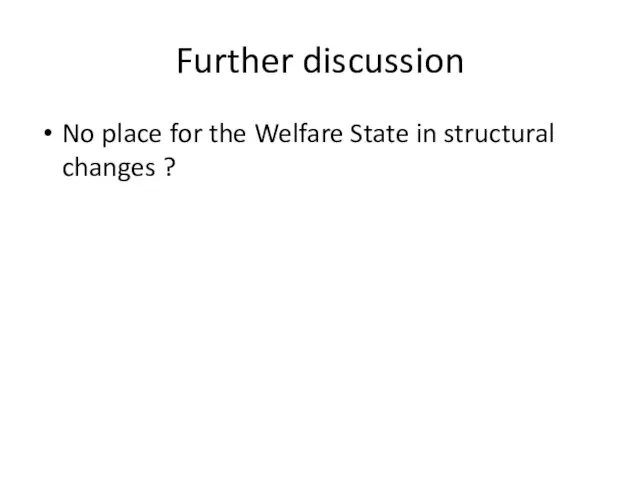Слайд 2References
Benner M. The Scandinavian Challenge. The Future of Advanced Welfare States in

the Knowledge Economy. Acta Sociologica Vol 46(2): 132–149. Scandinavian Sociological Association// SAGE. 2003
Esping-Andersen G., Korpi W. Social Policy as Class-Politics in Post-War Capitalsim: Scandinavia, Austria and Germany (1984) in J.H. Goldthorpe ‘Order and Conflict in Contemporary Capitalism’. Oxford: Clarendon Press. 179-208
Korpi W. The development of the Swedish welfare state in a comparative perspective, in The foundations of the Welfare State II. 1990 P.314-323
Stephens J.D. The Scandinavian Welfare States. Achievements, Crisis and Prospects// UNRISD. 1995
Scharpf F.W. Globalization and the welfare state. Constraints, challenges and vulnerabilities. The Year 2000 International Research Conference on Social Security. Helsinki// ISSA. Sept. 2000
Слайд 3Research Question
How Scandinavian welfare state is capable to response and adjust to

the global economic restructuration?
Слайд 4The Origins of the Scandinavian welfare state
The very beginning - Great depression

1930s – social policy hindered ; low social expenditures
The rise - Post-War period – security expenditures and level of consumption constituted the highest in the West
The fall – recession of 1980s, crisis of 1990s and internationalization of the markets
Слайд 5The Origins of the Scandinavian Welfare State
Basis of Scandinavian model:
Pragmatic and Ideological

purposes: equalized distribution of social resources and broadened social solidarity + social protection and full employment = cornerstone for productivity
Слайд 6The ‘Golden Age’
Time: Post-war period (until the mid 1970s)
Conditions: favorable environment for

the welfare to develop – WHY? – because, the government had the absolute power to control its economic boundaries and choose policies (employment, taxes, welfare provision etc.), because of the limited potential of international actors to control national government
Слайд 7The ‘Golden Age’
Flourishing welfare state:
Reform of social policy and extension of social

insurance (health system and pension system: universal coverage + income-related benefits; parental insurance system)
Expansion of public sector social services (medicine and education in particular)
Development of employment policy (active labor market policies – job creation, professional training etc., not only unemployment sibsidies)
Слайд 8Economic restructuration
Time: 1980s-1990s
Conditions: comfortable environment for the welfare state disturbed – WHY?

– because of economic internationlization and World recession of 1990s
The ability of Scandinavian welfare state model to maintain its comprehensiveness and efficiency becomes questioned
Слайд 9Arguments
Reasons for Crisis of Scandinavian countries
Too generous social entitlements -> system

failed
Structural changes in the advanced industrial economies -> system succeeded to adjust
Слайд 10Structural changes and internationalization
Economic restructuration: Maastricht Treaty and foundation of the EU,

the update of General Agreement on Tariffs and Trade and emergence of the WTO etc.
Result: restricted capacity for the government to regulate financial market
Restrictions imposed on on finance, products and employment systems of the Scandinavian welfare state
Change in labor-capital relations -> investment of profits abroad instead of home -> low levels of productivity in the state
Слайд 11Result
Scandinavian welfare state policies has changed and has been reduced
But: quantitative

instead of qualitative changes: institutional characteristics of the system, such as high income replacement rates, citizenship benefits, high provision of services and goods and the goals – social security, decommodification, income redistribution and labor mobilization remained stable.
Слайд 12Prerequisites for Scandinavian model to adjust
economic perspective: no need for drastic

change in a Scandinavian economic system (Scandinavian welfare state was organized around growth models in which the idea of export sector competitiveness was already a central one)
Political: support by political coalitions and institutionalization of the entitlements
Слайд 13Further discussion
No place for the Welfare State in structural changes ?













 Чувства и эмоции. Тест эмоций. Истоки негативных эмоций
Чувства и эмоции. Тест эмоций. Истоки негативных эмоций Устройства вывода информации
Устройства вывода информации Понятие субъекты и виду конституционно-правовых отношений
Понятие субъекты и виду конституционно-правовых отношений лекция 2
лекция 2 Психологические особенности личности спортсмена
Психологические особенности личности спортсмена Презентация на тему КРИТИЧЕСКИЕ НАРУШЕНИЯ ЖИЗНЕДЕЯТЕЛЬНОСТИ У ХИРУРГИЧЕСКИХ БОЛЬНЫХ
Презентация на тему КРИТИЧЕСКИЕ НАРУШЕНИЯ ЖИЗНЕДЕЯТЕЛЬНОСТИ У ХИРУРГИЧЕСКИХ БОЛЬНЫХ  Будь природе другом
Будь природе другом Екатеринбургский энергетический техникум
Екатеринбургский энергетический техникум Графический редактор PAINT
Графический редактор PAINT Презентация на тему Возвышение Москвы
Презентация на тему Возвышение Москвы  Место и роль разработки конкурентной стратегии в управлении собственным бизнесом
Место и роль разработки конкурентной стратегии в управлении собственным бизнесом Гиг-культура и фанфики
Гиг-культура и фанфики Лекция
Лекция Отчёт кафедры русского языка о работе в 2011 / 2012 уч. году
Отчёт кафедры русского языка о работе в 2011 / 2012 уч. году Правилатехникибезопасности!
Правилатехникибезопасности! 20140116_urok_litosfera
20140116_urok_litosfera АРХИТЕКТУРА ЭВМ И ВС
АРХИТЕКТУРА ЭВМ И ВС  Организационные и правовые способы исключения необоснованного вмешательства в деятельность государственных служащих
Организационные и правовые способы исключения необоснованного вмешательства в деятельность государственных служащих Николай Иванович Лобачевский
Николай Иванович Лобачевский Котирование ценной бумаги на интервальном промежутке времени. Инвестиционный договор
Котирование ценной бумаги на интервальном промежутке времени. Инвестиционный договор Центр практических навыков СтГМА
Центр практических навыков СтГМА Здоровьесберегающие технологии, как фактор повышения эффективности процесса обучения и воспитания учащихся
Здоровьесберегающие технологии, как фактор повышения эффективности процесса обучения и воспитания учащихся Правонарушение и юридическая ответственность
Правонарушение и юридическая ответственность Семья в моей жизни
Семья в моей жизни Мы будем продавать 3 продукта на тематику MARVEL. MVP
Мы будем продавать 3 продукта на тематику MARVEL. MVP Тимофеева Ирина 4 В кл. Гимназия №1
Тимофеева Ирина 4 В кл. Гимназия №1 Презентация на тему Полисы
Презентация на тему Полисы  Инструкция. Внесение карт наблюдений на портал
Инструкция. Внесение карт наблюдений на портал